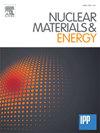Compositionally-driven surface nanostructuring on refractory compositionally complex alloys under low energy helium bombardment
IF 2.7
2区 物理与天体物理
Q1 NUCLEAR SCIENCE & TECHNOLOGY
引用次数: 0
Abstract
Additive manufacturing enables user-defined control of the compositional complexity, opening new design spaces for complex concentrated alloys (CCAs). Refractory CCAs may offer enhanced performance in the divertor region of a fusion reactor environment where plasma-facing materials will be subject to high temperatures, low energy He and D particles, and 14 MeV neutrons. In this work, specimens with the nominal composition of NbTaMoTi, NbTaMo, NbTaTi, and NbTa were fabricated via directed energy deposition (DED) then bombarded with 40 eV He ions to a fluence of 2x1026 m−2 at ∼ 1000 K. Post irradiation, the surface morphology and composition were examined with electron microscopy and x-ray photoelectron spectroscopy to offer information on the spatial distribution of surface nano-structuring. Sub-surface He bubbles driving the nano-structuring were examined with electron microscopy techniques. Analysis indicates the local composition directly influences the He bubble and tendril size, while the region with the highest complexity showed the shortest nano-structuring. Molecular Dynamics simulations complement the experimental results, showing comparable helium bubble growth and migration as a function of compositional complexity. This work demonstrates the compositional dependence of surface nanostructure formation of compositionally complex alloys, important for future design of complex plasma facing materials in fusion reactors.

低能氦轰击下难熔复合合金的成分驱动表面纳米结构
增材制造使用户能够控制成分的复杂性,为复杂的浓缩合金(cca)开辟了新的设计空间。在聚变反应堆环境中,面对等离子体的材料将受到高温、低能He和D粒子以及14 MeV中子的影响,耐火CCAs可以提供增强的性能。在这项工作中,通过定向能沉积(DED)制备了标称成分为NbTaMoTi, NbTaMo, NbTaTi和NbTa的样品,然后在~ 1000 K下用40 eV He离子轰击,影响为2x1026 m−2。辐照后,利用电子显微镜和x射线光电子能谱分析了表面形貌和组成,以了解表面纳米结构的空间分布。利用电子显微镜技术对驱动纳米结构的亚表面He气泡进行了研究。分析表明,局部成分直接影响He气泡和卷须的尺寸,而复杂性最高的区域具有最短的纳米结构。分子动力学模拟补充了实验结果,显示了氦泡的生长和迁移是组成复杂性的函数。这项工作证明了成分复杂合金表面纳米结构形成的成分依赖性,这对未来设计聚变反应堆中复杂等离子体面材料具有重要意义。
本文章由计算机程序翻译,如有差异,请以英文原文为准。
求助全文
约1分钟内获得全文
求助全文
来源期刊

Nuclear Materials and Energy
Materials Science-Materials Science (miscellaneous)
CiteScore
3.70
自引率
15.40%
发文量
175
审稿时长
20 weeks
期刊介绍:
The open-access journal Nuclear Materials and Energy is devoted to the growing field of research for material application in the production of nuclear energy. Nuclear Materials and Energy publishes original research articles of up to 6 pages in length.
 求助内容:
求助内容: 应助结果提醒方式:
应助结果提醒方式:


